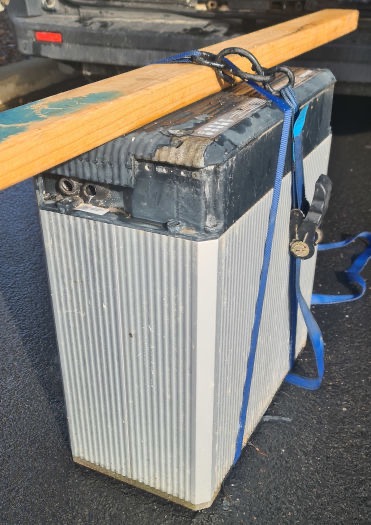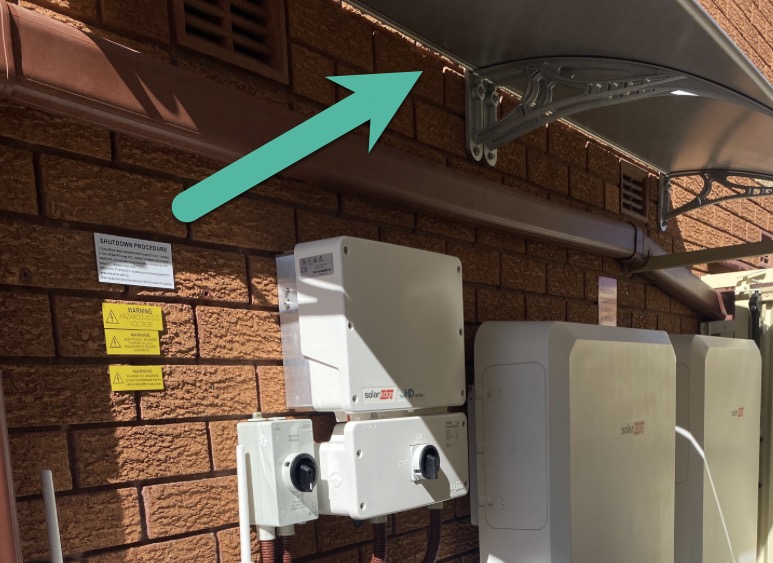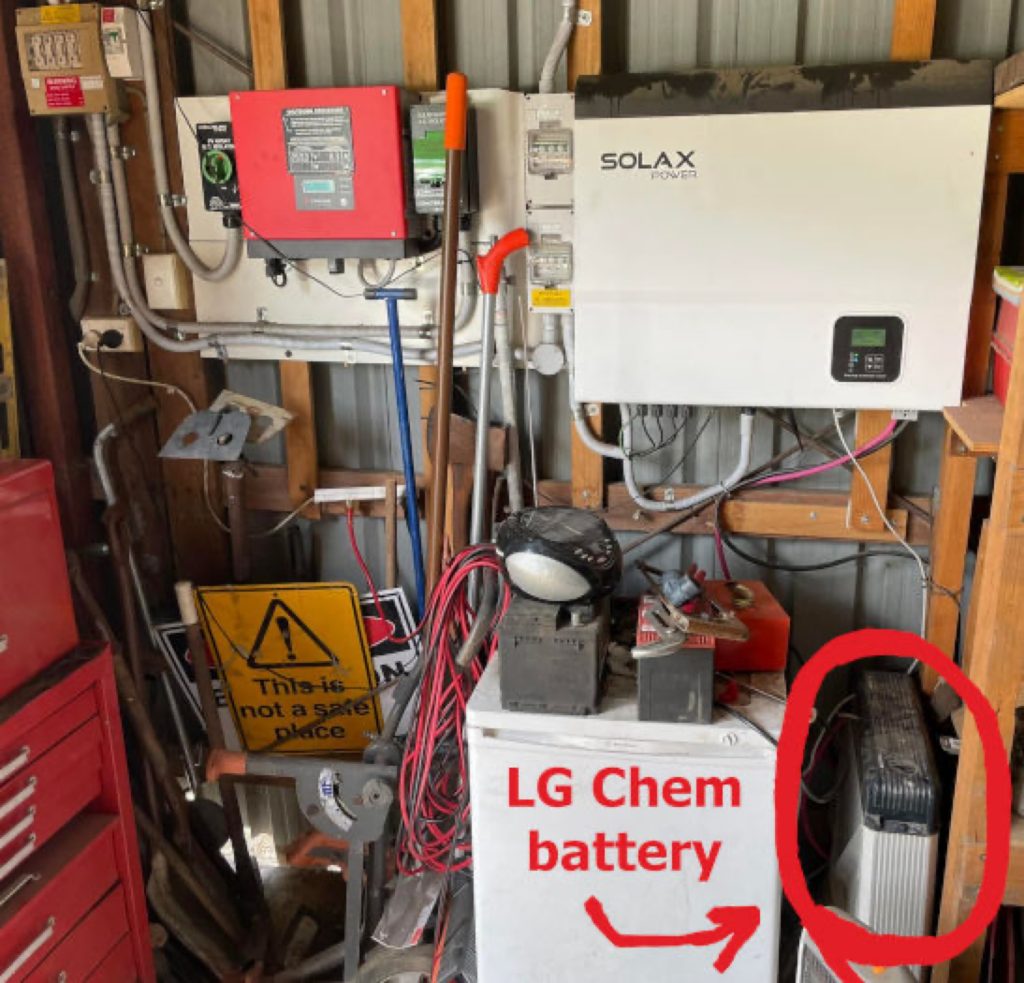Last Updated: 12th Dec 2024 By Anthony Bennett, Licensed Electrician, Roofer & Solar Installer. Fact checked by Ronald Brakels.
Solar Battery Installation – What You Should Know
Installing a home battery is straightforward electrical work. It involves physically mounting a battery on the wall or the floor, and – if required – hooking it up to an inverter. The inverter converts the battery’s DC power into the AC power that your home uses. The inverter will either:
- come with the battery – known as a ‘battery inverter’
- or be already installed, ready for a battery, and connected to your solar panels – known as a ‘hybrid inverter’.
But installing a home battery requires understanding many more standards than the average electrician knows:
- AS5139:2019 battery systems
- AS4777.2:2020 for grid-connected inverters
- AS5033:2021 solar arrays (probably)
- AS4509:2009 for stand-alone power systems (potentially)
In this article, I will discuss the various types of home battery installations, their requirements, and how to identify a quality installation.
Different Types of Battery Installations
- Basic Grid-Connected Battery: These don’t offer backup or blackout protection. They simply shift solar energy from the day into the evening.
- Grid-Connected Battery With Backup: These come in two flavours:
- Backup circuit runs through the inverter, limited by the kW rating of the inverter’s backup circuitry. If the inverter fails, everything on the backup circuits loses power.
- Backup circuit operates in parallel with the grid and activates an external gateway during a grid failure. This disconnects the mains supply and then re-energises the house with energy drawn from the battery.
- Off-Grid: These are expensive, custom setups, usually for remote areas. They are often designed based on how many kWh you use per day. They’ll have allowances for 3-4 days of autonomy and factor in some diesel consumption. As they are stand-alone systems they’ll need generator backup. Many battery makers will not offer a warranty on an off-grid battery that doesn’t have an auto-start generator attached.
How Long Does A Solar Battery Installation Take?
Installing an AC-coupled battery like Sonnen or Tesla is relatively quick. If there are no wiring or switchboard issues, an electrician and an assistant can typically complete it in half a day.
However, more complex installations, like hybrid systems with solar PV, additional components, longer cable runs, or switchboard upgrades, take longer. Depending on the team size, these can range from a full day to two days.
Installing a solar power and battery system can significantly alter a house’s electrical setup. This might necessitate a complete switchboard rebuild or a new main board installation. If setting up backup circuits reveals serious wiring issues (like mixed neutrals triggering RCD safety switches), they’ll need extra time for fault-finding.
But installation rarely takes more than two days unless an installation is unusually complex or off-grid.
Choosing Battery Installation Location
What The Rules Say
Australian rules about battery installation locations are stringent, often excluding seemingly sensible choices like near the switchboard. These regulations ensure evacuation paths remain clear. Additionally, a bedroom, kitchen, or living room behind the battery necessitates a fire-rated backboard.
The only get-out clause for many of these restrictions is placing the battery 300mm away from the wall. Provided there’s no other flammable surface nearby, this can avoid the need for fire-resistant material. This 300mm gap may seem surprisingly small, given there has to be 600mm side clearance and 900mm vertical clearance to the edge of fire-resistant material when installed against a wall with a “habitable” room behind it. This is because, with a gap, flames will tend to rise up rather than spread out.
Best Practices
So long as it’s cool and dry, a garage is often the best place for a battery. Though a bollard or other protection may be needed to prevent it being bumped by a vehicle, it’s better to care for the battery by not keeping it outside in the summer heat. Extreme heat is the number one issue that will shorten a lithium-ion battery’s life.
Batteries don’t really belong outside in the garden, or they can end up looking like this after a few years:

But not every garage is suitable. Some can be real heat traps, especially in the warmer parts of the country. A garage isn’t a good location if it’s hotter inside than out.
If your battery must go outside, shading it from the harsh Australian sun with an awning is a smart move:

Even better is a battery cover:

Identifying Quality In Solar Battery Installations
Hallmarks Of A Good Installation
Proper planning results in neat installs. A consumer can judge an installer by looking at the neatness of previous installations. Just bear in mind some equipment will always look a bit messy. For example, with a Sungrow or Goodwe system, all wires connect through plugs that insert into the bottom of the inverter:



Worst Practices
What are the hallmarks of a cheap, rushed, no-flux-given battery installation?
For battery hardware, Tesla Powerwall represents the high end, while AlphaESS is nearer the low end. Both are hard to fault aesthetically. However, AlphaESS’s lower price can attract less skilled, lower-paid installers. This means the essential switchboard work might not meet high standards.
Placement of the equipment can be a dead giveaway. Right next to the switchboard for the shortest possible cable run is efficient, but it can also be non-compliant if the battery is out in the weather. Using an awning to keep some rain off is better than nothing, but is often a bandaid.
Flexible conduit running all over your wall is a sign of bad or non-existent planning.
Don’t let the installer run off without teaching you how it all works. They should take you through the battery backup capability, shutdown and startup procedure. A phone app or PC monitoring should be installed and configured. Finally, ensure they get your email address to register the warranty and receive alarm notifications from the inverter.
Essential Installation Paperwork
Realistically, there are very few installers who provide a comprehensive suite of fully detailed documents that appear in the Clean Energy Council’s (CEC’s) advice:
Claiming STCs (Small-scale Technology Certificates), necessary only with solar panel installation, involves varied documentation standards. Frankly, if your Battery Energy Storage System (BESS) comes as a pre-tested, plug-and-play package, the specifics like cable sizes and protection device ratings are preset by the manufacturer. Re-recording this information again is just a waste of time.
The bare minimum documentation supplied should be a manufacturer instruction book, brochure, install guide, plus some instructions on how to shut down and start up the system. I also recommend the following in writing:
- Information on the sales quote detailing the promises made around performance, capacity and warranty.
- Detail on how much current it will normally deliver, and the surge capacity.
- How many years, cycles and kWhs you can expect before the warranty expires.
- The temperature range the battery will tolerate.
- Conditions for remote monitoring.
- Requirements for maintenance.
For the shutdown procedure, I prefer a numbered sequence, but the standards call for generic warning labels full of jargon. Either way, they must be indelible, so engraved Traffolyte labels are the norm.
Many companies prefer to include this information in a handover pack, provided when the system undergoes its final testing and commissioning.
Common Battery Installation Issues
Data Comms
Data connections and integration of other devices can be problematic. The best way to ensure reliable monitoring is with a cable plugged into your router. WiFi can fall over at the drop of a firmware update, change of occupant or telco update – and it can go unnoticed for months or years.
Reliable monitoring is usually a legal obligation for earth fault alarms on solar installations, but it’s also essential to maintain warranty coverage. In many cases, a battery warranty drops from ten years to three if connectivity isn’t maintained.
Customer Expectations
Customers often face early disappointment when they learn during installation that the battery can’t power their entire house, including the spa, stove, and air conditioner. This disappointment intensifies if they’ve chosen only one power and one light circuit, and then experience power failure because using the kettle while the fridge is running causes an overload.
Later, disappointment arrives again with the quarterly electricity bill. Assuming that spending a lot of money on a battery would be a magic bullet, but then finding a largely unchanged bill can open fresh wounds.
These problems go back to another two causes.
- Either the sales process has over-promised or glossed over the limitations most battery systems have, which means perhaps the system is overwhelmed by a rainwater pump when you flush the loo.
- Or the customer is so excited about the space-aged future that they can’t hear the warnings through their astronaut helmet nor see the limitations through the rose-tinted visor.
As a customer, you must have realistic expectations. Making a battery installation work economically will still require behaviour change and efficient practices.
Making a battery work in practice requires spending enough money on enough capacity while curbing battery draining enthusiasm. You shouldn’t need an electrical degree. If you document what you want to work when the grid has gone down, it’s up to the installer to deliver on that plan.
Single Phase vs. Three Phase
More brands, models, and options are available in single-phase.
The industry benchmark Tesla Powerwall is a single-phase AC coupled battery. It can be used on a 3-phase house, but it cannot support a 3-phase load without the grid available. If you have 3-phase solar power system installed, it won’t work in a grid outage, even if you have 3 Powerwalls. The same goes for any other single-phase battery arrangement.
Single-phase hybrid inverters = more current per phase
A generic single-phase 5kW hybrid solar system will be rated for 5kVA continuous output and a surge of 6 or 7kVA for ten seconds.
The 3-phase Fronius Gen24 Symo 10kW has a headline rating of 10kVA backup, which is true for 3 phase loads. However, as the capacity is spread across three phases, single-phase loads will only have 3.7kVA available, around 16amps. But the single-phase 10kW Fronius Primo model has a full 10kVA output or 43amps to a single-phase.
Watch out for inrush current
Why does this matter? Mainly because electric motors can draw around seven times their running current when starting. This is becoming less of a problem as more appliances use DC motors with soft start capabilities, but equally, I have seen first-hand a 5.5kVA machine that won’t start a second fridge if one is already running.
An example:
Say you come home and put the 2kW kettle on:
- and then flush the loo so the rainwater pump starts up,
- there can be extra load for an instant: 400w x 7 = 2.8kW.
- The total 4.8kW is around 25% more than the 3-phase 10kW Symo could handle
- Whereas the same scenario is less than half the muscle provided by the single-phase 10kW Primo
Larger 3-phase inverters are available, such as 15kW models from Goodwe (and Sungrow has one in the works), plus even larger units are available from some manufacturers. This means if you have a large air conditioner or other specific 3-phase load, they can be catered for.
How Can The Battery Be Installed For Easier Replacement?
To future-proof your battery, there are a few things you can do. Firstly, I wouldn’t install the battery in the roof space. They do it in the UK, and I have even seen it in Australia, notwithstanding legality. It pays to place the battery in an accessible location that isn’t in the weather and on a firm, sealed surface. It’s especially important if you’re dealing with a large form factor such as a Solar Edge or Powerwall.
I have had to move these monoliths out of trailers, across verandahs, through garden beds, up steps and through doorways with a variety of tools not limited to sack trucks, shovels and engine cranes. It’s dangerous in some instances, both to the workers, the surroundings and the expensive batteries.
Stackable modular batteries are a winner. They’re much easier to handle and safer for all concerned.
If possible, make sure you have room to expand beyond your first thought.
If you’re concerned about the longevity and adaptability of your battery installation and seek a universal option that allows for brand, size, or chemistry changes, selecting equipment with a 48-volt nominal battery will offer the most flexibility. However, there is little choice but to use the expensive inverters and batteries to get this universal solution.
Backup Power: Do You Really Need It?
Backup power is great, but remember, the Australian grid is very reliable, especially if you live within the black stump, so backing up everything in your home is probably unnecessary. Unless you have a monster battery system installation, look at only backing up essential circuits like the fridge, internet, lights, etc.
However, if you’ve invested in an advanced system to maintain your freezer or keep pet fish alive, you must fit a bypass switch. This ensures these backup circuits can still function if the inverter suffers a fault. Nothing will enrage an end user more than dropping 10, 20 or 30 thousand dollars on some technology that doesn’t do what it says on the tin, especially when the grid is still working.
Solar Battery Installation Safety
Unlike a cheap hoverboard or electric scooter, household solar batteries have vast amounts of R&D money spent on battery management systems, control software, durability assessment, warranty testing and statutory certifications. They are quite expensive compared to EV batteries or wholesale cells.
The main reason behind all this testing and regulation is lithium batteries can cause very hot, toxic and explosive fires if they reach a point of thermal runaway. If high temperatures trigger reactions, they can release oxygen and create intense, self-sustaining fires. These can only be completely extinguished by immersion in water or by letting them burn out.
These fires are as spectacular as they are rare. Although mandating a fireproof kiosk separate from your home to house a battery was considered for Australian standards, the responsible committee decided against it. Given that these batteries are often installed in garages alongside cars carrying 100 litres of highly flammable liquid, it appears we’ve recognised that these batteries are not as hazardous as some might suggest. In fact, fossil-powered cars are more likely to catch fire.
If you’re concerned about fire risk, lithium titanate batteries available from Arvio and Zenaji are inherently more stable. However, these need to be paired with some traditional off-grid type equipment using a nominal 48 volts. Or, of course, you could get a perfectly well-understood lead-acid battery, which will offer very modest performance.
Solar Battery Installation For EV Owners
There’s not much point in using batteries to charge batteries. Generally, the best way is to harvest renewables and put them directly in your car’s fuel tank (battery) or into the house. Pumping energy from one storage device to another, while losing 15% in the process and prematurely aging your expensive batteries doesn’t make much sense.
But if the smarts in your car and house aren’t on speaking terms, the car may guzzle whatever energy you have stored in the house relatively quickly. The problem is exacerbated by the relative sizes, with car batteries often being five times the size of a house unit. The good news is that you can install the solar battery so it will never dump energy into your car battery.
The easiest solution is to choose an EV charger with a well-proven integration or a third-party control software that manages energy consumption. I recommend using the best charger on the market and combining it with the same manufacturer’s solar, battery and hot water control ecosystem. Right now, that’s Fronius. However, you could find that Tesla, ChargeHQ, Sungrow, Wallbox, Schneider or any other makers have a similar solution that better matches your existing infrastructure.
If you’re looking for a great home battery installation, SolarQuotes can help by putting you in touch with installers we trust: